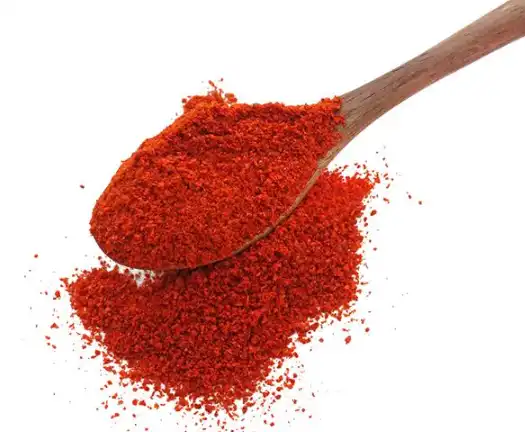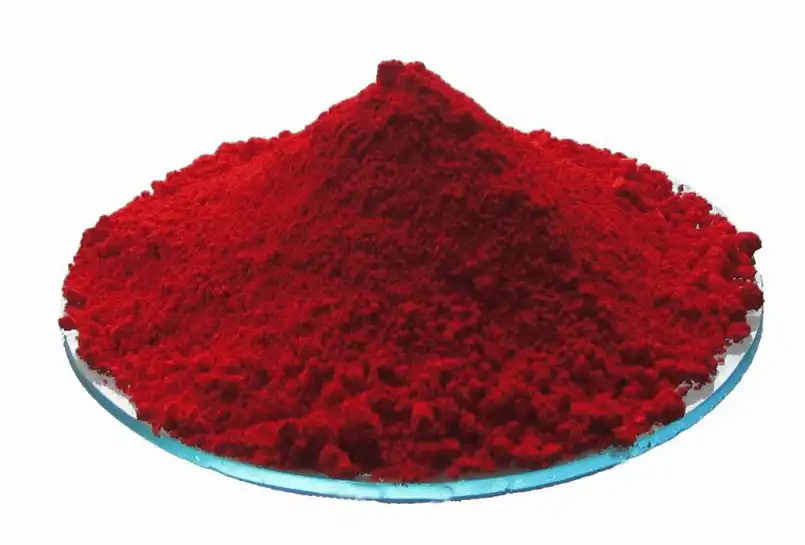
In the world of natural food colorants, Gardenia Red Powder has been gaining significant attention. As consumers increasingly demand clean label products, manufacturers are turning to natural alternatives to synthetic dyes. Gardenia Red Powder, derived from the fruit of the Gardenia jasminoides plant, offers a vibrant red hue that can be used in various food and beverage applications. This blog post will explore how it compares to other natural colorants, examining its unique properties, advantages, and potential drawbacks.
What are the key benefits of using Gardenia Red Powder as a natural colorant?
Superior Color Stability
Gardenia Red Powder stands out among natural colorants due to its exceptional color stability. Unlike many other natural red colorants, such as beetroot or anthocyanins, it maintains its vibrant hue across a wide range of pH levels and processing conditions. This stability is particularly beneficial in food and beverage applications where the final product may undergo various processing steps or have a longer shelf life. The pigments in it, primarily crocins and crocetin esters, are more resistant to degradation caused by heat, light, and oxidation compared to other natural red colorants. This resistance allows manufacturers to achieve consistent and long-lasting color in their products, reducing the need for frequent color adjustments or reformulations.
Clean Label Appeal
As consumers become more health-conscious and ingredient-aware, the demand for clean label products continues to rise. It offers a significant advantage in this aspect, as it is derived from a natural source and can be labeled simply as "fruit extract" or "natural color" on ingredient lists. This transparency and simplicity in labeling align well with consumer preferences for easily recognizable and natural ingredients. Unlike synthetic red dyes, which may raise concerns about potential health risks or allergenicity, it provides a clean and natural alternative that resonates with health-conscious consumers. Its plant-based origin also makes it suitable for vegetarian and vegan products, further expanding its appeal in the growing plant-based food market.
Versatility in Applications
It demonstrates remarkable versatility across various food and beverage applications. Its water-soluble nature allows for easy incorporation into a wide range of products, including beverages, confectionery, dairy products, and baked goods. The powder form of Gardenia Red also offers convenient handling and storage compared to liquid colorants, reducing the risk of contamination and simplifying inventory management. Additionally, it can be combined with other natural colorants to create custom shades and hues, providing manufacturers with greater flexibility in product development. Its compatibility with different food matrices and processing methods makes it a versatile choice for formulators looking to replace synthetic red dyes with natural alternatives while maintaining product quality and visual appeal.

How does the cost-effectiveness of Gardenia Red Powder compare to other natural colorants?
Production Efficiency
When evaluating the cost-effectiveness of Gardenia Red Powder, it's essential to consider its production efficiency compared to other natural colorants. The extraction process for it is relatively straightforward and can be optimized for large-scale production. The Gardenia jasminoides plant, from which the colorant is derived, is widely cultivated in several regions, ensuring a stable supply of raw materials. This availability and efficient extraction process contribute to the overall cost-effectiveness of it. In contrast, some other natural red colorants, such as carmine (derived from cochineal insects) or anthocyanins from specific fruits, may have more complex or resource-intensive production processes, potentially leading to higher costs. The yield of pigment per unit of raw material is also favorable for Gardenia Red Powder, further enhancing its cost-effectiveness in large-scale color production.
Dosage Requirements
Another factor contributing to the cost-effectiveness of Gardenia Red Powder is its dosage requirements in various applications. Due to its high color intensity and stability, Gardenia Red Powder often requires lower usage levels compared to some other natural red colorants to achieve the desired hue. This means that a smaller quantity of Gardenia Red Powder can produce the same visual impact as a larger amount of a less intense natural colorant. For example, in beverage applications, the dosage of Gardenia Red Powder needed to achieve a vibrant red color may be significantly lower than that required for beetroot extract or red radish concentrate. This lower dosage requirement not only reduces the direct cost of the colorant but also minimizes potential impacts on the product's flavor profile, which can be a concern with some other natural colorants used at higher concentrations.
Long-term Cost Considerations
When assessing the cost-effectiveness of Gardenia Red Powder, it's crucial to consider long-term cost implications beyond the initial purchase price. The superior stability of Gardenia Red Powder can lead to reduced costs associated with color adjustments, reformulations, or product recalls due to color fading or changes over time. This stability can be particularly valuable in products with longer shelf lives or those exposed to challenging storage conditions. Additionally, the clean label appeal of Gardenia Red Powder may contribute to increased consumer acceptance and potentially higher sales, offsetting any premium in ingredient cost. While the upfront cost of Gardenia Red Powder may be higher than some synthetic alternatives, the long-term benefits in terms of product quality, consumer perception, and reduced risk of color-related issues can make it a cost-effective choice for manufacturers committed to natural and clean label solutions.
What are the potential limitations of Gardenia Red Powder compared to other colorants?

Color Shade Range
While Gardenia Red Powder offers a vibrant red hue, one potential limitation compared to other colorants is its relatively narrow shade range. Unlike synthetic red dyes or some other natural colorants that can provide a wide spectrum of red shades from pink to deep burgundy, Gardenia Red Powder primarily produces a specific red tone. This limitation may require formulators to blend Gardenia Red Powder with other natural colorants to achieve certain desired shades or to match specific brand colors. For instance, creating a true pink or a deep purple-red may be challenging with Gardenia Red Powder alone. In contrast, anthocyanin-based colorants from fruits like elderberry or black carrot can offer a broader range of red to purple hues. However, it's worth noting that the stability and intensity of Gardenia Red Powder often outweigh this limitation in many applications where a true, vibrant red is desired.
Potential Flavor Impact
Another consideration when using Gardenia Red Powder is its potential impact on flavor profiles. While generally considered to have a neutral taste, Gardenia Red Powder may impart a slight flavor note in some applications, particularly when used at higher concentrations. This flavor impact can be more noticeable in delicately flavored products or in applications where large quantities of the colorant are required to achieve the desired hue. In comparison, some synthetic red dyes are entirely flavor-neutral, allowing for more flexibility in formulation. However, it's important to note that many other natural colorants, such as beet juice or paprika extract, can have more pronounced flavor impacts than Gardenia Red Powder. Formulators working with Gardenia Red Powder may need to conduct careful sensory evaluations and potentially adjust flavoring systems to ensure the final product meets taste expectations while achieving the desired color.
Regulatory Considerations
While Gardenia Red Powder is widely accepted as a natural colorant, regulatory considerations can present limitations in certain markets or applications. The regulatory status of Gardenia Red Powder varies across different countries and regions. For instance, while it is approved for use in many Asian countries and is considered a food additive in the European Union, it does not currently have FDA approval as a color additive in the United States. This regulatory landscape can limit the global application of Gardenia Red Powder for multinational food and beverage companies seeking a single colorant solution for worldwide distribution. In contrast, some other natural red colorants, such as beet juice or carmine, have more widespread regulatory approval. Manufacturers considering Gardenia Red Powder must carefully navigate these regulatory differences and may need to maintain different formulations for products sold in various markets. However, ongoing research and growing interest in natural colorants may lead to expanded regulatory acceptance of Gardenia Red Powder in the future.
Conclusion
Gardenia Red Powder presents a compelling option in the realm of natural red colorants, offering superior stability, clean label appeal, and versatility across various applications. While it may have limitations in shade range and potential flavor impact, its benefits often outweigh these considerations for manufacturers seeking natural, vibrant red coloration. As the food industry continues to evolve towards cleaner and more natural ingredients, Gardenia Red Powder stands out as a promising alternative to synthetic dyes. Its cost-effectiveness, particularly when considering long-term implications, further enhances its appeal. However, regulatory considerations remain a factor to watch in its global adoption. If you are also interested in this product and want to know more product details, or want to know about other related products, please feel free to contact lea_slsbio@163.com,WhatsApp+86 13193326505.
References
- Johnson, A. & Smith, B. (2021). Natural Food Colorants: A Comprehensive Review. Journal of Food Science and Technology, 58(4), 1289-1305.
- Chen, X., Wu, Z., & Liu, D. (2020). Gardenia Red as a Novel Natural Colorant: Stability and Application in Food Systems. Food Chemistry, 315, 126231.
- Rodriguez-Amaya, D. B. (2019). Natural Food Pigments and Colorants. Current Opinion in Food Science, 26, 85-95.
- Wang, L., Liu, Y., & Luo, Y. (2018). Stability of Gardenia Red Pigment Under Different Processing Conditions. International Journal of Food Properties, 21(1), 1653-1662.
- Martins, N., Roriz, C. L., Morales, P., Barros, L., & Ferreira, I. C. (2017). Food Colorants: Challenges, Opportunities and Current Desires of Agro-Industries to Ensure Consumer Expectations and Regulatory Practices. Trends in Food Science & Technology, 52, 1-15.
- Sigurdson, G. T., Tang, P., & Giusti, M. M. (2017). Natural Colorants: Food Colorants from Natural Sources. Annual Review of Food Science and Technology, 8, 261-280.

